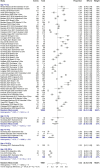Respiratory syncytial virus disease burden in children and adults from Latin America: a systematic review and meta-analysis
- PMID: 39478747
- PMCID: PMC11521816
- DOI: 10.3389/fpubh.2024.1377968
Respiratory syncytial virus disease burden in children and adults from Latin America: a systematic review and meta-analysis
Abstract
Background: Respiratory Syncytial Virus (RSV) is a common cause of lower respiratory tract infections (LRTI) and hospitalization worldwide. The impact of RSV in Latin America and the Caribbean (LAC) including expensive treatment options, such as palivizumab, have been extensively discussed. However, publications on the impact of RSV disease burden in the region are scarce. This systematic review aimed to determine the incidence and prevalence of RSV in LAC by age and RSV subtype.
Methods: We conducted a systematic review following Cochrane methods to evaluate the disease burden of RSV in LAC countries. We searched studies from January 2012 to January 2023 in literature databases and grey literature without language restrictions. We included guidelines, observational, economic, and surveillance studies from LAC countries. Pairs of reviewers independently selected, and extracted data from included studies. The risk of bias was assessed using the Study Quality Assessment Tools (NHLBI) and AGREE-II. We performed proportion meta-analyses using methods to stabilize the variance. The protocol was registered in PROSPERO (CRD42023393731).
Results: We included 156 studies, mainly from Brazil (25%), Colombia (14.5%), and Argentina (13.8%), as well as four clinical practice guidelines. Most studies were cross-sectional (76.9%) and were classified as low risk of bias (52.6%). The majority included inpatients (85.6%), pediatric (73.7%), and normal-risk patients (67.1%). The highest pooled prevalence was estimated in patients <1 year old (58%), with type A and B prevalence of 52 and 34%, respectively. The RSV-LRTI incidence was 15/100 symptomatic infants aged <2 years old, and the ICU admission was 42%. The RSV-LRTI lethality was 0.6, 3% in patients aged <2 and 0-5 years old, respectively, and 23% among >65 years old high-risk patients. The identified guidelines lack methodological rigor and have limitations in their applicability. The seasonality was more evident in South America than in Central America and The Caribbean, with a clear gap during the pandemic.
Conclusion: This is the most exhaustive and updated body of evidence describing a significant burden of RSV in LAC, particularly at the extremes of life, and its seasonality patterns. Our findings could contribute could contribute facilitating effective prevention and treatment strategies for this significant public health problem.
Systematic review registration: PROSPERO CRD UK (registration number: CRD42023393731).
Keywords: Latin America and the Caribbean; bronchiolitis; incidence; lower respiratory tract infection; mortality; prevalence; respiratory syncytial virus; seasonality.
Copyright © 2024 Ciapponi, Palermo, Sandoval, Baumeister, Ruvinsky, Ulloa-Gutierrez, Stegelmann, Ruesjas, Cantos, LaRotta, de Almeida and Bardach.
Conflict of interest statement
JL works for Vaccine Medical, Pfizer SAS, Bogotá, Colombia and RA works for Pfizer Inc., New York, New York, United States. RU-G has participated recently in scientific events sponsored by Pfizer and AstraZeneca, received honoraria as a speaker by Pfizer, and in advisory boards by MSD, all related to RSV prevention and treatment. The remaining authors declare that the research was conducted in the absence of any commercial or financial relationships that could be construed as a potential conflict of interest. The author(s) declared that they were an editorial board member of Frontiers, at the time of submission. This had no impact on the peer review process and the final decision.
Figures




References
-
- Suh M, Movva N, Jiang X, Bylsma LC, Reichert H, Fryzek JP, et al. . Respiratory syncytial virus is the leading cause of United States infant hospitalizations, 2009-2019: a study of the national (Nationwide) inpatient sample. J Infect Dis. (2022) 226:S154–63. doi: 10.1093/infdis/jiac120 - DOI - PMC - PubMed
-
- Shi T, Denouel A, Tietjen AK, Campbell I, Moran E, Li X, et al. . Global disease burden estimates of respiratory syncytial virus-associated acute respiratory infection in older adults in 2015: a systematic review and Meta-analysis. J Infect Dis. (2020) 222:S577–83. doi: 10.1093/infdis/jiz059, PMID: - DOI - PubMed
-
- Shi T, McAllister DA, O’Brien KL, Simoes EAF, Madhi SA, Gessner BD, et al. . Global, regional, and national disease burden estimates of acute lower respiratory infections due to respiratory syncytial virus in young children in 2015: a systematic review and modelling study. Lancet. (2017) 390:946–58. doi: 10.1016/S0140-6736(17)30938-8, PMID: - DOI - PMC - PubMed
-
- Ledbetter J, Brannman L, Wade SW, Gonzales T, Kong AM. Healthcare resource utilization and costs in the 12 months following hospitalization for respiratory syncytial virus or unspecified bronchiolitis among infants. J Med Econ. (2020) 23:139–47. doi: 10.1080/13696998.2019.1658592, PMID: - DOI - PubMed
-
- Doucette A, Jiang X, Fryzek J, Coalson J, McLaurin K, Ambrose CS. Trends in respiratory syncytial virus and bronchiolitis hospitalization rates in high-risk infants in a United States nationally representative database, 1997-2012. PLoS One. (2016) 11:e0152208. doi: 10.1371/journal.pone.0152208, PMID: - DOI - PMC - PubMed
Publication types
MeSH terms
LinkOut - more resources
Full Text Sources
Medical
Miscellaneous

